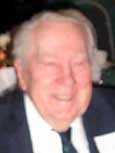George Condon
Chronicling Cleveland
with Wit & WisdomGeorge is the second most famous person to be born in Falls River, Mass. The first was Lizzie Borden. George left Falls River at the age of 6 when he and his large Irish family moved to what is now Ohio City. George was the youngest of eight children. His father was born in County Waterford, Ireland and his mother in County Mayo, Ireland. They met and married in Falls River. George, ever the historian, knows a lot about his home town, including that it was once the home of the world's largest cotton industry - before the cotton industry moved south. And also that Lizzie Borden was never convicted and that the Borden name we are all so familiar with in dairy products is the same Borden family. The family moved to the Cleveland area because his mother had relatives here. At the time Cleveland was referred to as "Little Achill" (Achill Island, part of County Mayo, Ireland) and naturally Irish families were drawn to the area. 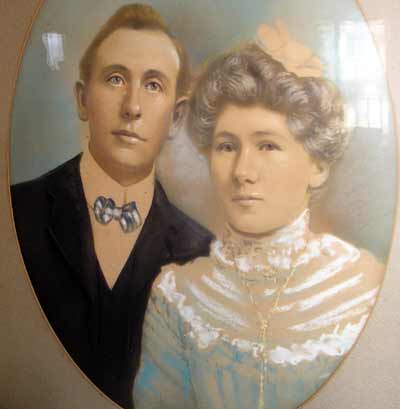
George Condon's parents
He attended St. Patrick's on Bridge; the "largest parochial school in the United States." In his mind he can still see the writing on the façade on the Woodline street side. It said "Girls School" on the left and "Boys School" on the right. He was taught by The Christian Brothers, the same order that taught his father back in Ireland. "My father" says George "only went to school for 6 years and he had the education and intelligence of one that was college educated." George graduated and went to West Tech, where he was in the Class of '35. This was the heart of the Depression so when he left High School he went right to work. His first job was at Atlas Display Fixture Company on Rockwell Ave. He was paid $5.00 and streetcar passes for his 5 and a half day week. "In those days you could ride the street car unlimited for 50 cents a week. But who had 50 cents? It may as well have been a million." George also worked at the Block Clothing Store on Superior, where he learned to do office work. 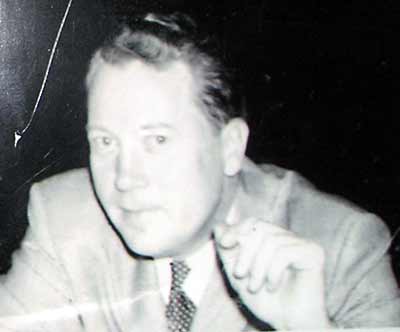
At this time, Ohio State University was begging for students. Tuition came to about $80.00 a year; George saved up and entered OSU's school of Journalism. There were about 13,000 students enrolled at the time and that was considered to be a high number. He paid about $10 a month to live in a rooming house with his friends and in 1941 he graduated with a Bachelor of Science degree in Journalism. While in school, George met his future wife, Marjorie Smith, from Springfield, Mass. He was the news editor at the Daily Lantern (the OSU paper) and Marge was a reporter. He thought he didn't stand a chance with this beautiful and popular woman, but he was very much mistaken.
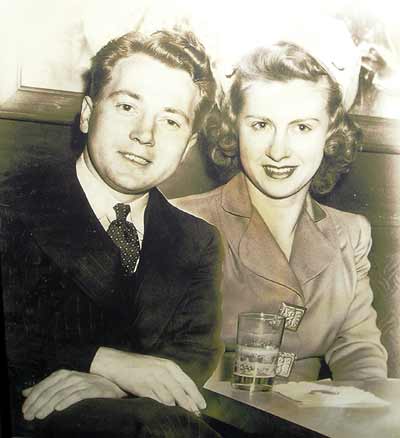
George and Marge Condon
They married in 1942 and had seven children. Marge died in 2000 and George mourns her every bit as much today as he did then.One of George and Marge's daughters died shortly after birth and their son, John, died 5 years ago at the age of 50. George's ither son, also named George, is also a journalist working with the Copley newspaper chain as a White House Correspondent. He has worked in this capacity since the Carter administration. 
George Condon's son and daughter with Laura and President George W. Bush
His daughter Susan Condon Love is the Homes Editor for the Cleveland Plain Dealer. Susan is married to Brian and they have two children, Brian Jr. and Kelley. His oldest child, Theresa (Terry) spent some time supervising R&R for troops in Viet Nam. "I think she was running the U.S. government for awhile. She was actually in Viet Nam. She didn't just work from a desk back home." Daughter Katie is a nurse at Johns Hopkins and Mary was the assistant to the Mayor of Lakewood. Mary is married to Peter and they have two children, Peter Jr. and Patrick. Peter Jr. is a nuclear fission expert and received his diploma from President George Bush. Patrick graduated from Notre Dame and went to England to tech in Liverpool with the Jesuits. George had been the Editor of the Mount Pelier, Ohio newspaper. "I was also the only one on the staff" he laughs. He got a call from Ohio State University telling him that Mt. Union College needed a P.R. person. It took him an entire day of bus rides to get to Alliance, the home of Mt. Union, but he got there. "Mt. Union was a great Methodist School. The first thing they asked me was if I was Catholic. I told them I was. They said that was great - they needed more Catholics. And I got the job." Eventually he got another call, this time from his home town paper in Springfield. But on the same day he got a call from the Cleveland Plain Dealer. The Plain Dealer offered him $50.00 a week, the highest pay of any of the staff. George had previously been making $65.00. But he took the Cleveland job and stayed there for 41 years.
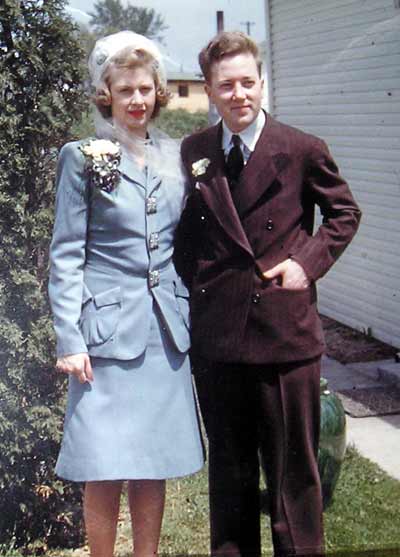
Marge and George Condon
He first joined the staff of the Plain Dealer in 1943. He was the very first television critic the Plain Dealer had. As such he was in on the ground floor of this huge news and entertainment industry. He remembers so much about the early days of television. In 1948 there was only 1 station, channel 5. It was run by Jim Hanrahan. Soon after Channel 5 was joined by Channel 3. In 1949 Channel 9 came on board (now channel 8).A television signal in those days would only travel 30-40 miles. 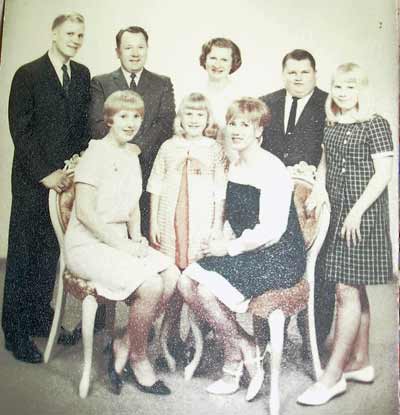
George and Marge Condon Family
He remembers the day Channel 9 went on the air. Their studio was on Playhouse Square at the Lake Theater. The transmitter was on Pleasant Valley Road. There was to be a big party in the Red Room of the Cleveland Hotel. All of the television critics were invited, which included George and Stanley Anderson from the Cleveland Press and Elmore Bacon from the News. People from New York and all over the area were coming to this party - a new station was a big event. But, as George explains, there was a problem.
"They opened the bar around 6:30 and the first show was going on the air at 8:00. By 8 there were any number of roaring drunks in the room. Herb [Mayer] had hired Doc Spears, an old college professor, to be Program Director. Doc told me in an interview he planned on putting Shakespeare on the air. Frank Snyder was hired as G.M. At 7:30 I asked for a run down of the upcoming programs, supposed to start at 8. Doc said ask Frank. Frank said ask Doc. Everybody was drunk and nobody knew what was going on."
Morey Amsterdam was the Master of Ceremonies for the event and had no idea what to do. So he decided to interview the 3 TV. writers. "He got a lot of laughs because he couldn't remember the call letters of the station or any of our names. They put a lot of music on to make up for it." But the night didn't end there. He looked outside and made a call asking "Why am I looking at red skies?" As it turned out the Central Market was burning, there was a 5 alarm fire in progress. Since George was the closest his paper asked him to cover it and he called in a first edition story. 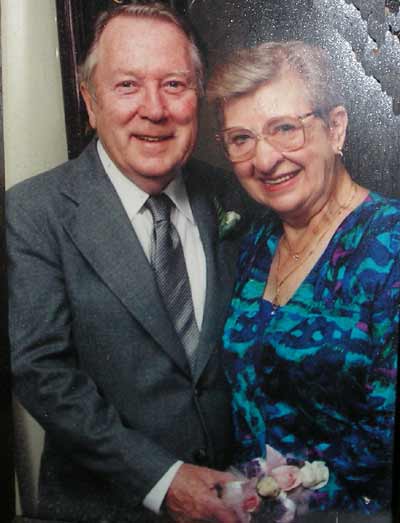
George and Marge Condon
Amazingly, the night didn't end there either. He and Frank Snyder and Frank's wife Barbara went to the Artists and Writers Club (also known as the 1011 Club). It was on the 10th floor of the Hollenden Hotel and George recalls it as "The world's greatest cheat spot." Soon after they got there they heard a terrible crashing noise. For the first time ever the Club was being raided by the State Liquor Authority. It closed down permanently after that. "So in one night" George says "we got a new television station, had a five alarm fire and got raided by the state liquor authority. Now that's a night to remember." 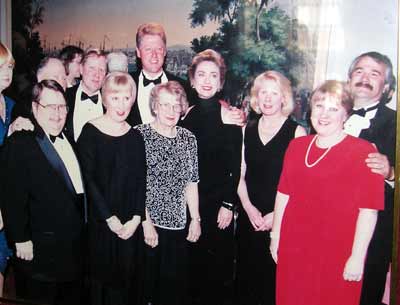
George Condon Family with
President Bill Clinton and Hillary Clinton
George did the television assignment for 14 years starting in 1948. "What a brutal assignment that was" jokes Condon "14 years of watching television." He found the first years to be interesting; it was new and innovative. He thinks the whole idea of cable television is, in his words "ridiculous" "We had free television and we exchanged it for a box office television. I just don't understand it, it's ridiculous."When the Federal Communications Commission (FCC) regulated broadcasting there was a controlled amount of minutes that could be used for commercials and companies could not own more than five radio stations and three television stations. Cleveland had 5 or 6 radio stations "and now there are 30 or 40. For what? I don't understand it." George says the FCC can no longer control broadcasting and attributes that to "the reason Howard Stern can get away with his kind of filth. When I was doing my column if someone said 'Damn' they'd be investigated and punished. This is not progress, it is anarchy. Now you can do whatever you want. You call that progress?" 
President Bill Clinton with George Condon
George's first book was Cleveland-The Best Kept Secret. At the time he wrote it he was doing his TV column, seven days a week. A representative of Doubleday Books called and told them about a new series they were working on, highlighting American cities. They wanted George to write the Cleveland book. It was not an easy decision for him. He had 17 columns to fill on Sunday and 7 a week. But he knew he wanted to write the book, so he made the deal and actually signed a contract to write three books. "I thought it was insane, but I signed it." He was always interested in writing about outlandish personalities like Tom Johnson and his administration (Johnson was 35th Mayor of Cleveland from 1901 and 1909). He also writes about Cyrus Eaton and Newton D. Baker. Baker was the 37th Cleveland Mayor serving from 1912 to 1915 and Cyrus Eaton was a financier and philanthropist.
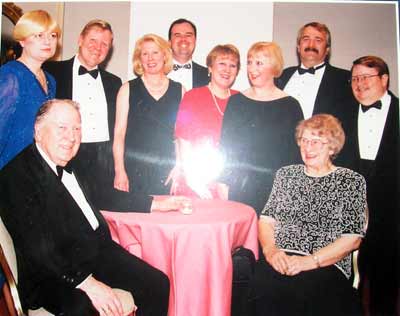
George and Marge Condon Family
His second book Laughter from the Rafters was also a collection of columns. By this time he had been promoted to writing a daily column, five days a week. This was more of a general column found on the Op/Ed page. This freed him up to do research on another book. This one was to be the story of the Erie Canal, a truly fascinating story as George tells it. He found the book great fun to write and even more fun to investigate. "It would make a great movie. It has everything in it; suspense, romance, violence, mystery. It's all in the history of the Erie Canal." 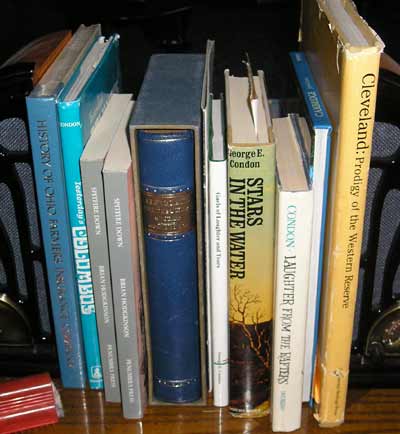
Books authored by George Condon
Click for more on George Condon's Books
He is currently writing 2 more books, one of which is a series of pieces on Cleveland he's been writing over the years. One such story is the story of the pirate William Henry "Bully" Hayes. Hayes was born in Cleveland in 1832. He stood 6'4", an unheard of height for the time and has the dubious honor of being considered the last of the South Seas Pirates. Bully was also written about by James Michener.

President George HW Bush and Marge Condon
There is also the story of Constance Fennimore Woolsen, the niece of James Fennimore Cooper. Her sister married William Mather and gave birth to a son, W.G. Mather, a major influence in Cleveland society, development and history. When her sister died, Constance helped raise Mather.
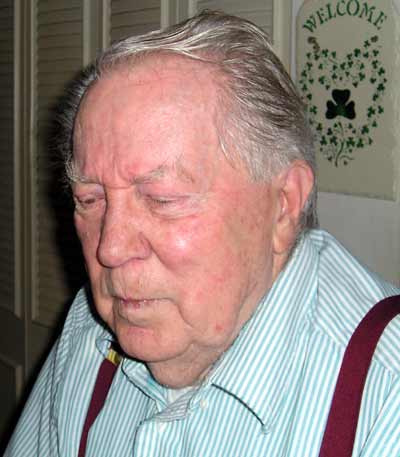
George Condon in 2007
His other book is also a collection, but in this case it is a collection of stories about people (including what he calls Looney Editorial People), especially the artists. Cleveland was once the Comic Strip Capital of the U.S. Both NEA (Newspaper Enterprise Association) and King Fisher were both headquartered here. Cleveland supplied the country with such classics as Barney Google and Freckles. "These are amusing stories whereas the other book is much more historical and serious." You won't find a newfangled computer on George Condon's desk. Well sure he has one, but as he says "I'm really very happy with my IBM electric. I don't doubt there are advantages to a computer, that's why I bought one in the first place, but it seems that the advantages are beyond me."
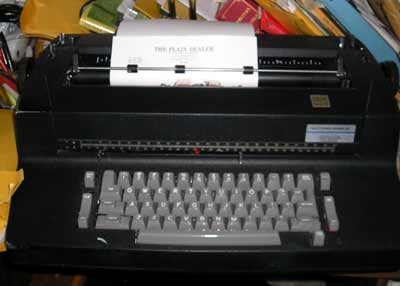
George Condon's IBM Selectric Typewriter ready to go
In fact he finds the computer to be what he calls "a treacherous machine" doing things at will and against his will. "It changed my double space writing into single space without even consulting me!" He does use it sometimes and is in the process of learning "just enough to get me through." On November 6, 2006 George turned 90 years of age. The Irish Archives Society has recently joined so many other institutions in formally acknowledging some of his contributions. On February 22, 2007 he was honored at the annual Walks of Life awards ceremony. (More photos and information here). George has packed a tremendous amount into those 90 years and has a lot left he wants to do and a lot of stories left to tell. 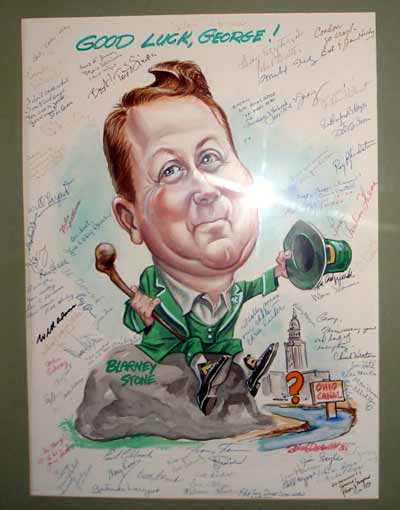
From friends at the Plain Dealer
He is truly a fascinating man with a keen sense of history and humor. Time spent with him is both informative and funny. One would be wise to find an opportunity to talk to him, or better yet, to let him talk to you. 
George Condon in 2007
Seldom can a person teach so much about things we think we already know and leave us smiling and wanting more. George Condon is that person.
Profiled by Debbie Hanson (1/07)

Update: George Condon passed away at age 94 on Friday October 7, 2011. Cleveland journalism will never be the same.
Top of Page
Back to Irish in Cleveland
Back to Cleveland Senior Profiles
| 





